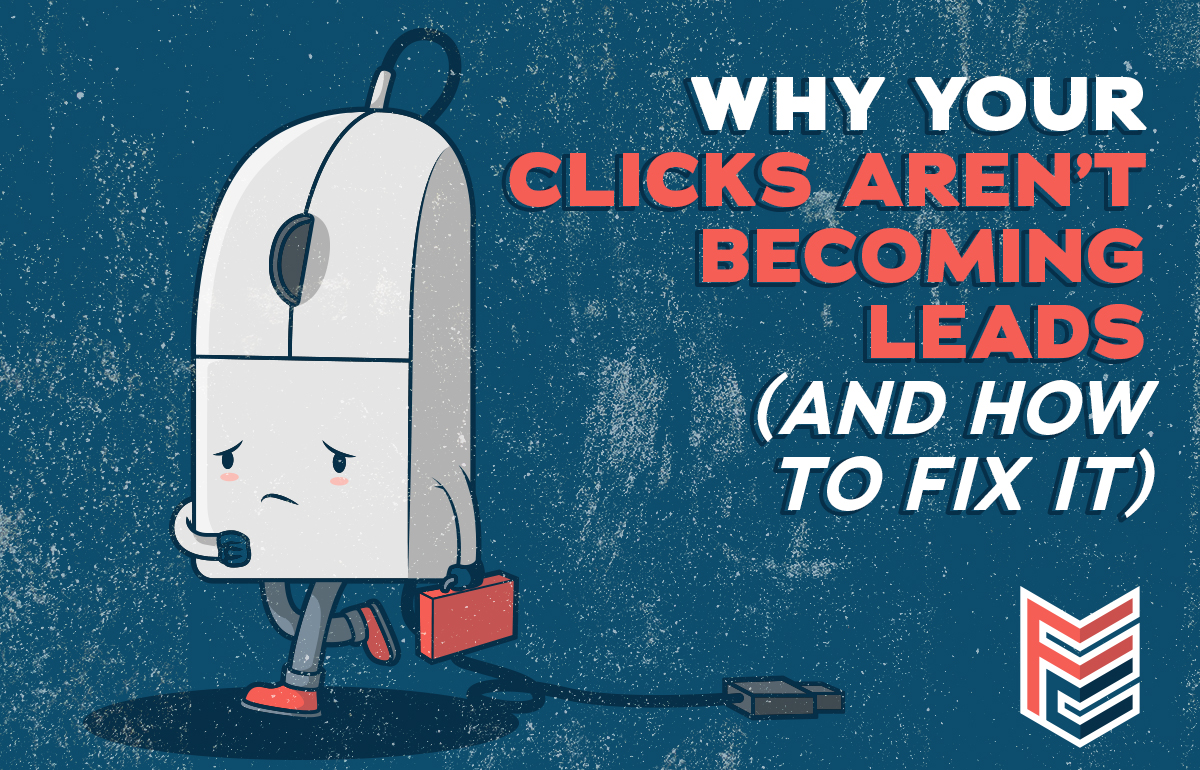
Why Your Clicks Aren’t Becoming Leads (and How to Fix It)
Your website should be a powerhouse—a lead-generating machine that builds your brand and drives your business forward. In the busy landscape of the digital world, a static website that simply exists is no longer enough. If you find yourself wondering why your website isn’t converting clicks into leads, you’re not alone. Let’s explore the common pitfalls of lead generation and offer a roadmap to transform your online presence.
The Silent Struggle of Lead Generation
 Many businesses invest in a visually appealing website, only to find that leads don’t pour in as expected. Imagine how much worse it is for companies who haven’t updated their website this decade! The culprit of slow lead generation often lies in a failure to leverage key factors like convicting writing, engaging/informative content, and compelling Calls to Action (CTAs).
Many businesses invest in a visually appealing website, only to find that leads don’t pour in as expected. Imagine how much worse it is for companies who haven’t updated their website this decade! The culprit of slow lead generation often lies in a failure to leverage key factors like convicting writing, engaging/informative content, and compelling Calls to Action (CTAs).
Content: Crafting a Compelling Narrative
Content is the soul of your website. However, many businesses miss the mark by just providing information without strategic intent or a brand throughline. You need content that not only informs but also tells a narrative. There’s a story behind your business; tell it. There’s a reason your company is unique; share it. You’re passionate about your business, tell the world why.
Here are some tips for writing engaging, clear, and productive copy on your website:
- Know your audience. Make sure your language and tone resonate with that audience.
Cut unnecessary words. Can you remove a word or phrase and not change the meaning of your sentence? Cut it. You won’t impress anyone with verbose, thesaurus-laden, eloquent, articulate, poignant, sentences full of impressive filler words and wordy turns of phrase. Readers will lose interest. Prove to your reader that you value their time. Get to the point.- Use power words. Choose impactful, simple, everyday words that convey your message with precision. Avoid using words to try and seem smart. Even though you may think you sound mellifluous, it will not be efficacious, and the results may be pernicious (see how pretentious that sounded?).
- Break information down. Use bullet points, short sentences, and catchy headlines to make important information more easily scannable by your reader.
- Avoid jargon and overused phrases. The first time you reference an acronym, it should be spelled out. Don’t lose casual readers who might be genuinely interested in your idea. Avoid business buzzwords, industry slang, and other pitfalls. Challenge: Try to stay awake while reading the following:
- “In order to seamlessly leverage our cutting-edge synergies, we need to think outside the box and proactively ideate scalable turnkey solutions that move the needle and enhance our value proposition, fostering a paradigm shift in our customer-centric, mission-critical approach, ultimately driving impactful outcomes and maximizing stakeholder value across all touchpoints in this competitive landscape.”
- Does it sound like an actual human being wrote this? No. You’re a human. Write like one!
The Power of Directive CTAs: From Invitation to Action
A compelling Call to Action is the bridge between a visitor and a lead. Directive CTAs should be clear, concise, and to the point. Whatever the “ask,” be mindful of what you request a visitor do. How insane is it to request their personal information, ask them to sign up for email marketing, or ask for 10 minutes of their time without providing a powerful, valuable incentive? Ensure your ask isn’t tone-deaf, or you’ll turn away a visitor immediately. Instead, deliver immediate value and use the CTA to invite them to even more value down the road.
Writing a compelling CTA requires a delicate blend of clarity, urgency, and value proposition. Let’s explore the key elements of a strong CTA and compare to some less effective examples that won’t inspire action.
Elements of a Strong CTA:
- Clarity: A strong CTA leaves no room for confusion. It clearly states what action the visitor should take.
- Urgency: Creating a sense of urgency encourages immediate action. Time-sensitive language can be highly effective.
- Value Proposition: Conveying the benefit of taking action is crucial. Visitors should understand what they gain from engaging with the CTA.
- Visibility: A strong CTA stands out. Whether through contrasting colors, bold typography, or strategic placement, it should capture attention.
- Action-Oriented Language: Use verbs that prompt action. Passive language will dilute the impact of your CTA.
Examples of Lackluster CTAs:
- Weak language/lack of urgency: “See More” – This CTA lacks specificity and fails to convey the value of taking action.
- Vague Instruction: “Click Here” – This CTA is generic and doesn’t inform the visitor about the purpose or benefit of clicking.
- Overly Complex: “View More Information About Our Extensive Resource Center and How it can Help You by Clicking Now” – This CTA is too wordy and might overwhelm the reader.
- Hidden CTA: Placing the CTA at the bottom of a long page without repetition means visitors may miss it.

Examples of Strong, Compelling CTAs:
- Clear Value Proposition: “Unlock Your Free E-Book Now”
- Urgency and Benefit: “Limited-Time Offer: Save 20% Today!”
- Action-Oriented Language: “Get Started on Your Fitness Journey”
- Personal Touch: “Claim Your Personalized Demo”
Marketing: Beyond the Basics
There’s much more to building a cohesive lead-generating machine of a website beyond content, messaging, and CTAs. Channels like Pay-Per Click, Seach Engine Optimization, display ads, social media, influencer collaboration, and much more should be leveraged to drive users to your website. If you think your audience isn’t on social media, you’re wrong. Engaging marketing content drives interested parties to your website, where informative landing pages (now with strong writing) educate, answer, and convert clicks to legitimate leads. Investing in a diverse range of marketing strategies helps you cast a broader net for new business.
Conclusion: Transforming Digital Presence into Leads
The secret to an effective lead-generating website is, at its roots, persuasive, appealing writing and powerful calls to action. Without these core tenets, spending time, effort, and money on diversified advertising is a waste of resources. We encourage all businesses to carefully and critically evaluate the success of their writing. Check out more articles for our tried-and-true playbook for success in a digital age.
Ready to transform your website into a lead-generation powerhouse? Connect with us for a consultation. Your community is waiting, and the time for meaningful leads is now.

